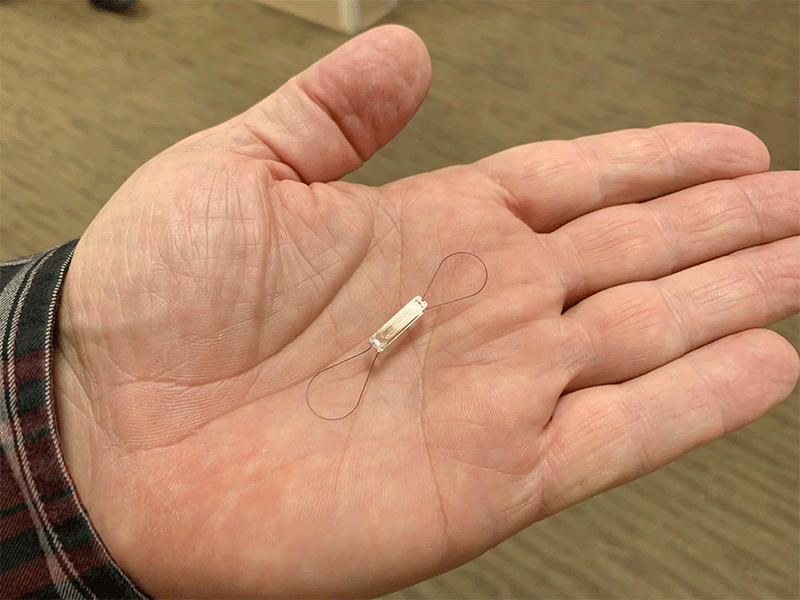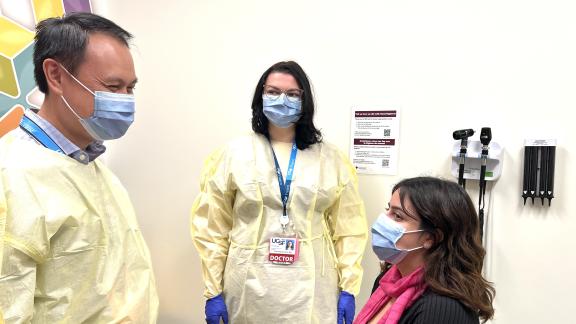
Checking blood pressure and weight daily for indications of a worsening heart condition is a way of life for patients with heart failure, but UCSF Fresno cardiologist Richard G. Kiel, MD, has introduced a new implantable monitoring system that detects subtle variations in heart function before numbers on scales and blood pressure gauges raise alarms.
About two-dozen patients in the San Joaquin Valley so far this year have received CardioMEMS™ HF System, a miniature wireless monitor that tracks changes in pulmonary artery pressures before the appearance of symptoms, such as swollen ankles and shortness of breath.
“It is a simple, elegant system that can help keep patients healthy, allowing them to feel better and do more, walk farther, spend more time with their families and have a better quality of life,” Dr. Kiel said. “It also has been shown to reduce re-hospitalizations for heart failure symptoms, which can be very costly.”
The implantable monitor is a battery-free pressure-sensing device that is smaller than a dime. Other implantable monitors have been larger, the size of pacemakers, had wires that were threaded directly into the heart and needed battery replacement. And none of the prior monitors have been shown to be really effective at reducing re-hospitalizations and improving quality of life for patients with heart failure, Dr. Kiel said.
Patients who receive CardioMEMS™ HF System have the wireless device permanently implanted into an artery in the lungs. The minimally-invasive surgical procedure involves a catheter inserted through a vein in the leg or neck. Patients can be up and back walking within a short time.
The monitor is ingeniously simple, Dr. Kiel said. One time a day, patients lay on a pillow-device for 30 seconds while heart rates and artery pressures are wirelessly transmitted to a secure website that physicians can access for review.
CardioMEMS™ HF System was approved by the U.S. Food and Drug Administration in May 2014. The first surgical procedure to implant the monitor in the western United States was performed at UC San Francisco School of Medicine in September 2014 by Liviu Klein, MD, associate professor of medicine, and director of Cardiology Clinical Research and the Mechanical Circulatory and Heart Failure Device Programs. Dr. Kiel was introduced to the monitor in 2016 by Dr. Klein, during an Advanced Heart Failure and Cardiac Transplant Fellowship at UCSF. Following the one-year fellowship, Dr. Kiel returned to UCSF Fresno and in late 2019 successfully brought the implantable monitoring program to Community Regional Medical Center (CRMC).
Besides its miniature size, lack of wires and battery, the beauty of monitor is that it gives physicians information about the status of the heart in real time so adjustments can be made to medications before conditions deteriorate, Dr. Kiel said.
Patients who receive the heart monitor have been diagnosed as having Class III heart failure, meaning they become short of breath with mild activities, such as getting up out of bed, taking a shower, getting dressed, putting on shoes. Patients who benefit the most are those who have been admitted to the hospital at least once in the last year, Dr. Kiel said. Patients who are appropriate to receive the monitor are those who respond to diuretic therapy.
Research has shown that increases in pressures captured by the monitor precede symptoms of worsening heart failure by a couple of weeks. “The pressure tells us how much fluid patients are retaining or how much they are losing — and over time that is what leads to symptoms, Dr. Kiel said. “The pressure builds up higher and higher, and more of the fluid is pushed into the tissues of the lungs and pushed into tissues of the legs resulting in shortness of breath, swelling and all the symptoms of heart failure.”
The monitor’s ability to alert physicians to changes in patients’ heart conditions has been shown to reduce the rate of heart failure re-hospitalizations, which saves patients and hospitals money, Dr. Kiel said. “The biggest part of expenditure on heart failure really comes from what happens in the hospital. So really if we can prevent one hospitalization it’s probably paying for all the costs associated with this device.”
About 6.5 million adults in the United States have heart failure, according to the federal Centers for Disease Control and Prevention. Dr. Kiel estimates 1,000 patients with heart failure in the Fresno area could potentially benefit from the CardioMEMS™ implant.
The device also saves time for patients – and physicians. Physical monitoring of a patient with heart failure involves patients weighing themselves, taking their blood pressure and letting physicians know of any changes or symptoms. Patients need appointments for routine checkups, and physicians have to set aside a 20 to 30-minute block of time for office visit that could be done at home in 30 seconds by the implantable monitor.
“The monitor just makes it easier and more efficient for everybody,” Dr. Kiel said.
Patients who have received the monitor also report an improvement in their overall well-being with the device lessening anxiety that can be associated with heart failure and the constant monitoring required to remain healthy. “We should do everything to keep patients healthy and to improve the quality of their lives,” Dr. Kiel said. “This certainly is one of those things.”
Providing CardioMEMS™ to patients in the Valley has been a joint effort of UCSF Fresno and CRMC. “It’s more than I could do my myself and more than even a team of doctors could do,” Dr. Kiel said. “It takes some dedicated employees to really help drive it forward and make sure it’s successful and as effective as possible.”




